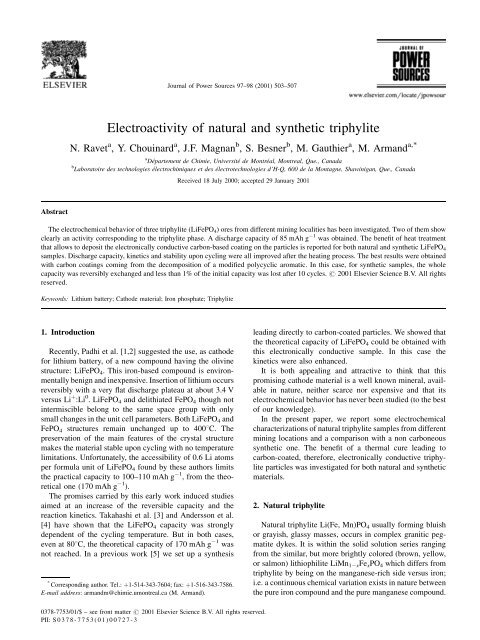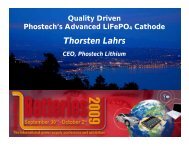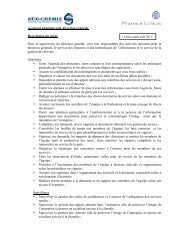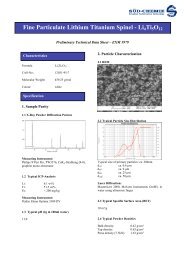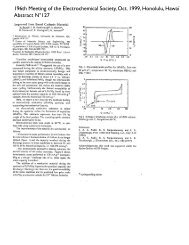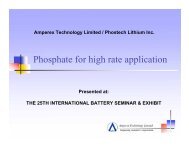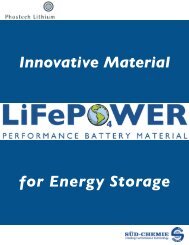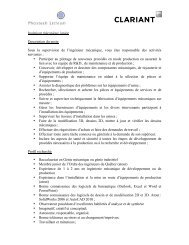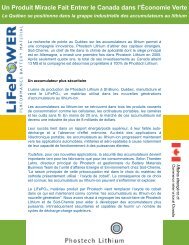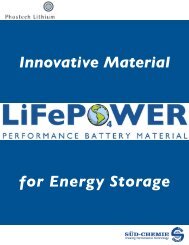Electroactivity of natural and synthetic triphylite - Phostech Lithium inc.
Electroactivity of natural and synthetic triphylite - Phostech Lithium inc.
Electroactivity of natural and synthetic triphylite - Phostech Lithium inc.
- No tags were found...
You also want an ePaper? Increase the reach of your titles
YUMPU automatically turns print PDFs into web optimized ePapers that Google loves.
Journal <strong>of</strong> Power Sources 97±98 2001) 503±507<br />
<strong>Electroactivity</strong> <strong>of</strong> <strong>natural</strong> <strong>and</strong> <strong>synthetic</strong> <strong>triphylite</strong><br />
N. Ravet a , Y. Chouinard a , J.F. Magnan b , S. Besner b , M. Gauthier a , M. Arm<strong>and</strong> a,*<br />
a DeÂpartement de Chimie, Universite de MontreÂal, Montreal, Que., Canada<br />
b Laboratoire des technologies eÂlectrochimiques et des eÂlectrotechnologies d'H-Q, 600 de la Montagne, Shawinigan, Que., Canada<br />
Received 18 July 2000; accepted 29 January 2001<br />
Abstract<br />
The electrochemical behavior <strong>of</strong> three <strong>triphylite</strong> LiFePO 4 ) ores from different mining localities has been investigated. Two <strong>of</strong> them show<br />
clearly an activity corresponding to the <strong>triphylite</strong> phase. A discharge capacity <strong>of</strong> 85 mAh g 1 was obtained. The bene®t <strong>of</strong> heat treatment<br />
that allows to deposit the electronically conductive carbon-based coating on the particles is reported for both <strong>natural</strong> <strong>and</strong> <strong>synthetic</strong> LiFePO 4<br />
samples. Discharge capacity, kinetics <strong>and</strong> stability upon cycling were all improved after the heating process. The best results were obtained<br />
with carbon coatings coming from the decomposition <strong>of</strong> a modi®ed polycyclic aromatic. In this case, for <strong>synthetic</strong> samples, the whole<br />
capacity was reversibly exchanged <strong>and</strong> less than 1% <strong>of</strong> the initial capacity was lost after 10 cycles. # 2001 Elsevier Science B.V. All rights<br />
reserved.<br />
Keywords: <strong>Lithium</strong> battery; Cathode material; Iron phosphate; Triphylite<br />
1. Introduction<br />
Recently, Padhi et al. [1,2] suggested the use, as cathode<br />
for lithium battery, <strong>of</strong> a new compound having the olivine<br />
structure: LiFePO 4 . This iron-based compound is environmentally<br />
benign <strong>and</strong> inexpensive. Insertion <strong>of</strong> lithium occurs<br />
reversibly with a very ¯at discharge plateau at about 3.4 V<br />
versus Li ‡ :Li 0 . LiFePO 4 <strong>and</strong> delithiated FePO 4 though not<br />
intermiscible belong to the same space group with only<br />
small changes in the unit cell parameters. Both LiFePO 4 <strong>and</strong><br />
FePO 4 structures remain unchanged up to 4008C. The<br />
preservation <strong>of</strong> the main features <strong>of</strong> the crystal structure<br />
makes the material stable upon cycling with no temperature<br />
limitations. Unfortunately, the accessibility <strong>of</strong> 0.6 Li atoms<br />
per formula unit <strong>of</strong> LiFePO 4 found by these authors limits<br />
the practical capacity to 100±110 mAh g 1 , from the theoretical<br />
one 170 mAh g 1 ).<br />
The promises carried by this early work induced studies<br />
aimed at an <strong>inc</strong>rease <strong>of</strong> the reversible capacity <strong>and</strong> the<br />
reaction kinetics. Takahashi et al. [3] <strong>and</strong> Andersson et al.<br />
[4] have shown that the LiFePO 4 capacity was strongly<br />
dependent <strong>of</strong> the cycling temperature. But in both cases,<br />
even at 808C, the theoretical capacity <strong>of</strong> 170 mAh g 1 was<br />
not reached. In a previous work [5] we set up a synthesis<br />
* Corresponding author. Tel.: ‡1-514-343-7604; fax: ‡1-516-343-7586.<br />
E-mail address: arm<strong>and</strong>m@chimie.umontreal.ca M. Arm<strong>and</strong>).<br />
leading directly to carbon-coated particles. We showed that<br />
the theoretical capacity <strong>of</strong> LiFePO 4 could be obtained with<br />
this electronically conductive sample. In this case the<br />
kinetics were also enhanced.<br />
It is both appealing <strong>and</strong> attractive to think that this<br />
promising cathode material is a well known mineral, available<br />
in nature, neither scarce nor expensive <strong>and</strong> that its<br />
electrochemical behavior has never been studied to the best<br />
<strong>of</strong> our knowledge).<br />
In the present paper, we report some electrochemical<br />
characterizations <strong>of</strong> <strong>natural</strong> <strong>triphylite</strong> samples from different<br />
mining locations <strong>and</strong> a comparison with a non carboneous<br />
<strong>synthetic</strong> one. The bene®t <strong>of</strong> a thermal cure leading to<br />
carbon-coated, therefore, electronically conductive <strong>triphylite</strong><br />
particles was investigated for both <strong>natural</strong> <strong>and</strong> <strong>synthetic</strong><br />
materials.<br />
2. Natural <strong>triphylite</strong><br />
Natural <strong>triphylite</strong> LiFe, Mn)PO 4 usually forming bluish<br />
or grayish, glassy masses, occurs in complex granitic pegmatite<br />
dykes. It is within the solid solution series ranging<br />
from the similar, but more brightly colored brown, yellow,<br />
or salmon) lithiophilite LiMn 1 x Fe x PO 4 which differs from<br />
<strong>triphylite</strong> by being on the manganese-rich side versus iron;<br />
i.e. a continuous chemical variation exists in nature between<br />
the pure iron compound <strong>and</strong> the pure manganese compound.<br />
0378-7753/01/$ ± see front matter # 2001 Elsevier Science B.V. All rights reserved.<br />
PII: S 0378-775301)00727-3
504 N. Ravet et al. / Journal <strong>of</strong> Power Sources 97±98 2001) 503±507<br />
Table 1<br />
Chemical analysis <strong>of</strong> <strong>natural</strong> <strong>and</strong> <strong>synthetic</strong> <strong>triphylite</strong> a<br />
Sample Fe %) Mn %) Li %) K %) Ca %) P %) Maximum purity %)<br />
Maine 20.2 4.9 3.6 1.1 14.6 71<br />
Dakota 21.1 7.6 2.0 1.7 1.6 15.2 45<br />
Palermo 20.6 5.2 3.6 1.3 14.6 73<br />
Synthetic 34.5 3.7 18.8 84<br />
a Data were obtained by ICP.<br />
The structures <strong>of</strong> the two minerals are the same <strong>and</strong> therefore<br />
any differences in physical properties between the two<br />
would be related to the iron/manganese ratio. In order to<br />
investigate the in¯uence <strong>of</strong> this ratio on the electrochemical<br />
behavior <strong>of</strong> <strong>triphylite</strong>, three samples from different mining<br />
localities Palermo Mine North Gorton, NH; Lord's hill,<br />
Maine; Custer, SD) were purchased from Excalibur Mineral<br />
Company. Well-de®ned <strong>triphylite</strong> crystals are quite rare.<br />
More commonly <strong>triphylite</strong> occurs as compact cleavable<br />
masses with intergrown crystal clumps. The surfaces<br />
exposed at room atmosphere are weathered <strong>and</strong> may contain<br />
the delithiated material FePO 4 .<br />
3. Experimental<br />
Triphylite ores were ground as received in a ball mill in<br />
deoxygenated isopropanol. After grinding, powders were<br />
dried <strong>and</strong> stored under inert atmosphere prior to use.<br />
Classical <strong>synthetic</strong> <strong>triphylite</strong> was prepared in house. This<br />
new process leading to non conductive samples is not yet<br />
fully optimized <strong>and</strong> the obtained materials are not perfectly<br />
stoichiometric.<br />
Chemical analyses were made by ICP to determine the<br />
stoichiometry <strong>and</strong> the phase purity <strong>of</strong> materials were<br />
checked by X-ray diffraction.<br />
Fig. 1. First voltammetric scans a); evolution <strong>of</strong> the discharge capacity upon cycling b) for <strong>natural</strong> <strong>and</strong> <strong>synthetic</strong> <strong>triphylite</strong> samples. Results obtained by<br />
cyclic voltammetry scan rate 20 mV h 1 ; temperature 808C; electrolyte PEO±Li salt O/Li ˆ 20/1).
N. Ravet et al. / Journal <strong>of</strong> Power Sources 97±98 2001) 503±507 505<br />
Electronically conductive coatings were obtained for<br />
classical <strong>and</strong> <strong>natural</strong> LiFePO 4 , from the decomposition<br />
<strong>of</strong> organic substances. We report here results obtained with<br />
sucrose, cellulose acetate <strong>and</strong> a modi®ed polycyclic. The<br />
<strong>triphylite</strong> powder was mixed with a solution <strong>of</strong> the above<br />
carbon precursors thereafter named organic substances).<br />
The dry additive corresponds to 5% <strong>of</strong> the <strong>triphylite</strong><br />
weight. After drying, blends are submitted to heat treatment<br />
at 7008C under argon atmosphere for 4 h. The<br />
quantity <strong>of</strong> carbon-coated represents about 1% in weight<br />
<strong>of</strong> the material.<br />
The electrochemical investigations were made in lithium<br />
batteries with a polyethylene oxide) PEO) bistri¯uoromethanesulfonimide<br />
lithium salt LiTFSI) as<br />
electrolyte with a ratio O/Li <strong>of</strong> 20. Composite cathodes<br />
were made <strong>of</strong> electroactive material, ketjen black, PEO in<br />
the proportions 33.8; 9.5; 56.7 by weight, acetonitrile was<br />
added to dissolve the PEO. These components were intimately<br />
mixed together <strong>and</strong> spread on a stainless steal<br />
current collector 1.7 cm 2 ). Investigations were performed<br />
at 808C.<br />
4. Results <strong>and</strong> discussion<br />
Different color powders results <strong>of</strong> ores grinding. The<br />
sample from Maine is beige, the one from Palermo is gray<br />
<strong>and</strong> an intense blue-green color was observed for the powder<br />
originating from Dakota. The <strong>synthetic</strong> material is very pale<br />
green.<br />
The shape <strong>of</strong> the three <strong>natural</strong> powders was observed by<br />
scanning electronic microscopy. In all cases, it contains<br />
small micro-particles <strong>and</strong> some huge massive grains having<br />
excaped the grinding process, with sizes up to 50 mm.<br />
Unfortunately, the <strong>triphylite</strong> content <strong>of</strong> ores was<br />
unknown.<br />
The chemical composition <strong>of</strong> the investigated materials is<br />
summarized in Table 1. The detection limit <strong>of</strong> elements<br />
corresponds to 1% by weight <strong>of</strong> the solid. The maximal<br />
purity given in the Table 1 was calculated considering that<br />
only the <strong>triphylite</strong> phase contains the element which presents<br />
the highest departure from the stoichiometry lithium for<br />
<strong>synthetic</strong> <strong>and</strong> Dakota <strong>triphylite</strong>, iron <strong>and</strong> manganese for<br />
Maine <strong>and</strong> Palermo samples). This is a maximum purity<br />
Fig. 2. Tenth voltammetric scans a); evolution <strong>of</strong> the discharge capacity upon cycling b) for carbon-coated <strong>natural</strong> <strong>and</strong> <strong>synthetic</strong> <strong>triphylite</strong> samples. Results<br />
obtained by cyclic valtammetry scan rate 20 mV h 1 ; temperature 808C; electrolyte PEO±Li salt O/Li ˆ 20/1).
506 N. Ravet et al. / Journal <strong>of</strong> Power Sources 97±98 2001) 503±507<br />
because it is obvious, in the case <strong>of</strong> Palermo <strong>and</strong> Maine<br />
samples that iron is involved in other compounds like iron<br />
oxides, pyrite, etc. Samples from Maine <strong>and</strong> Palermo are<br />
quite similar in term <strong>of</strong> purity <strong>and</strong> manganese contain. The<br />
X-ray patterns obtained for these samples show that the<br />
pr<strong>inc</strong>ipal phase is <strong>triphylite</strong>.<br />
The chemical composition obtained for the Dakota ore is<br />
quite disappointing <strong>and</strong> the X-ray analysis con®rmed that<br />
this sample was pr<strong>inc</strong>ipally not <strong>triphylite</strong>.<br />
4.1. Electrochemical measurements<br />
First voltammetric scans Mac Pile, Claix, France) performed<br />
at 20 mV h 1 on the untreated samples are presented<br />
Fig. 1a <strong>and</strong> the capacities exchanged upon cycling are shown<br />
Fig. 1b.<br />
The three <strong>natural</strong> samples show the oxidation <strong>and</strong> reduction<br />
peak characteristic <strong>of</strong> <strong>triphylite</strong> material. An interesting<br />
feature <strong>of</strong> these <strong>natural</strong> samples versus the <strong>synthetic</strong> one, is<br />
that electrochemical processes are shifted anodically. This is<br />
probably due to the presence <strong>of</strong> the small amounts <strong>of</strong><br />
manganese. For the Maine sample, electrochemical investigations<br />
were also made using a liquid electrolyte up to<br />
4.5 V but no additional electrochemical activity corresponding<br />
to the Mn 2‡ /Mn 3‡ couple was observed. As expected the<br />
Dakota sample show only a small electrochemical activity<br />
corresponding to 20% <strong>of</strong> the theoretical value. The voltammogram<br />
shapes <strong>of</strong> Palermo <strong>and</strong> Maine samples are similar<br />
<strong>and</strong> for both almost 50% <strong>of</strong> the theoretical capacity is<br />
reached. Taking into account that the maximal purity <strong>of</strong><br />
these samples is 70%, the LiFePO 4 phase activity is about<br />
70% in both Palermo <strong>and</strong> Maine ores. Upon cycling we<br />
observe for the later samples, a fade <strong>of</strong> the electrochemical<br />
activity <strong>and</strong> after 10 cycles, 20% <strong>of</strong> the initial capacity was<br />
lost. The same behavior was also observed for the <strong>synthetic</strong><br />
sample. In this case only 70% <strong>of</strong> the initial capacity is<br />
retained after 10 cycles.<br />
4.2. Influence <strong>of</strong> carbon coatings on the electrochemical<br />
behavior <strong>of</strong> <strong>natural</strong> samples<br />
For <strong>natural</strong> samples, coatings were obtained by carbonization<br />
<strong>of</strong> modi®ed polycyclic aromatic. The electrochemical<br />
behavior <strong>of</strong> these materials is shown Fig. 2. We reported here<br />
the 10th voltammetric scan because carbon-coated samples<br />
undergo an activation process during the ®rst cycles<br />
Fig. 3. Tenth voltammetric scans a); evolution <strong>of</strong> the discharge capacity upon cycling b) for carbon-coated <strong>synthetic</strong> <strong>triphylite</strong> samples. Results obtained by<br />
cyclic valtammetry scan rate 20 mV h 1 ; temperature 808C; electrolyte PEO±Li salt O/Li ˆ 20/1).
N. Ravet et al. / Journal <strong>of</strong> Power Sources 97±98 2001) 503±507 507<br />
Fig. 2a). For the Dakota sample, no improvement due to<br />
the coating is visible. As seen before, the shape <strong>of</strong> Palermo<br />
<strong>and</strong> Maine samples are very similar. Peaks appears to be<br />
sharper than for untreated samples while the peak current<br />
density in the reduction process is twice higher. Oxidation<br />
<strong>and</strong> reduction processes occurs within a narrower potential<br />
range. These later observations indicate an <strong>inc</strong>rease in the<br />
reaction kinetics. The capacities exchanged are slightly<br />
higher but the real improvement is seen with the stability<br />
<strong>of</strong> exchanged charge upon cycling Fig. 2b). For the Palermo<br />
sample, the highest capacity 54.8%) is reached during the<br />
2nd cycle <strong>and</strong> after 10 cycles, 96% <strong>of</strong> this initial capacity is<br />
retained.<br />
We have to point out that no real improvement in term <strong>of</strong><br />
capacity due to the carbon coating was observed. The best<br />
results were obtained with Palermo sample with a capacity<br />
<strong>of</strong> 54.8%. This capacity could be limited by the purity <strong>of</strong> the<br />
ore that could be inferior to 70%. Actually X-ray diffraction<br />
cannot detect impurities in quantity smaller than 5%. These<br />
ores contain probably a lot <strong>of</strong> different compounds. The<br />
other <strong>and</strong> most likely cause <strong>of</strong> capacity limitation comes<br />
from the large particles. Grinding have to be optimized in<br />
order to reduce the particles size.<br />
4.3. Influence <strong>of</strong> the carbon sources<br />
For the <strong>synthetic</strong> material, carbon coatings were obtained<br />
from the decomposition <strong>of</strong> three different substances. The<br />
bene®t <strong>of</strong> these treatments on the kinetics appears clearly in<br />
Fig. 3. For the untreated sample oxidation <strong>and</strong> reduction<br />
processes trail over a wide potential range. After coating,<br />
peaks get sharper <strong>and</strong> reduction occurs within a 100 mV<br />
range in the case <strong>of</strong> the samples treated with the modi®ed<br />
polycyclic hydrocarbon <strong>and</strong> the cellulose acetate. The<br />
sucrose treated sample gave less ef®cient results seen on<br />
the kinetics Fig. 3a). The reduction capacity varies from<br />
83% modi®ed polyaromatic) to 87% cellulose acetate)<br />
which, taking into account the purity <strong>of</strong> the <strong>synthetic</strong><br />
sample, represents the whole capacity <strong>of</strong> this material.<br />
The best results concerning the stability upon cycling were<br />
obtained for the sample treated with modi®ed polyaromatic.<br />
After 10 cycles less than 1% <strong>of</strong> the initial capacity was lost<br />
Fig. 3b).<br />
5. Conclusion<br />
The well-de®ned redox activity <strong>of</strong> double phosphates<br />
from various sources corroborates their interest as a new<br />
family <strong>of</strong> ``plateau-type'' electrodes whose advantages over<br />
``sloping-type'' materials are worth consideration. Besides,<br />
attention should be drawn to the existence <strong>of</strong> an appreciable<br />
redox activity, yet unoptimized, from a <strong>natural</strong> compound<br />
found in relative abundance in nature; the triphyllite family<br />
represents one <strong>of</strong> the most abundant lithium ore. Moreover,<br />
we show that, carbon-coated electronically conductive particles<br />
could be obtained as a post treatment by a simple <strong>and</strong><br />
inexpensive way. Resulting materials exhibit enhanced<br />
capacity, kinetics <strong>and</strong> stability upon cycling. Again, these<br />
®ndings point towards the chemical sustainability <strong>of</strong> this<br />
environmentally benign compound.<br />
References<br />
[1] A.K. Padhi, K.S. Nanjundaswamy, J.B. Goodenough, in: Proceedings<br />
<strong>of</strong> the 189th ECS Meeting, LA, May 1996.<br />
[2] A.K. Padhi, K.S. Nanjundaswamy, J.B. Goodenough, J. Electrochem.<br />
Soc. 144 1997) 1188.<br />
[3] M. Takahashi, S. Tobishima, K. Takei, Y. Sakurai, in: Proceedings <strong>of</strong><br />
the 10th IMLB, Como, Italy, May 2000.<br />
[4] A.S. Andersson, J.O. Thomas, B. Kalska, L. HaÈggstroÈm, Electrochem.<br />
Solid-State Lett. 3 2000) 66.<br />
[5] N. Ravet, J.B. Goodenough, S. Besner, M. Simoneau, P. Hovington, M.<br />
Arm<strong>and</strong>, in: Proceedings <strong>of</strong> the 196th ECS Meeting, Honolulu,<br />
October 1999.


